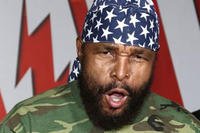"The Green Berets," starring John Wayne, encountered scathing reviews upon its release in 1968. The rare movie supporting the United States' involvement in the Vietnam War at the time was generally regarded as 2 hours, 22 minutes of mind-numbing drivel, with legendary film critic Roger Ebert calling it "cruel and dishonest and unworthy of the thousands who have died there." The New York Times blasted the film as “so unspeakable, so stupid, so rotten and false in every detail.”
But in one important aspect, "The Green Berets" was a film unlike any other during Wayne's half-century career. As part of his research for the film, the legendary actor had an opportunity to tour Vietnam in 1966 and connect with regular GIs like he had never done before.
Wayne realized how much his presence meant to beleaguered service members.
"If nothing else, [this] gave the kids something else to write home about," he told the Stars and Stripes military newspaper. "Life is so monotonous over there that they have nothing to put in their letters."
Wayne's first visit to Vietnam came amid a burgeoning national discussion about whether the United States should be involved militarily in the conflict, a difference of opinion that began almost immediately after President Lyndon B. Johnson first sent American troops there in 1965. While Wayne traveled to Southeast Asia, anti-war protests, draft-card burnings and marches decrying American troops’ involvement became more prevalent.
Wayne cringed at those demonstrations. Once labeled a draft dodger who, some felt, put his career above serving his country during World War II, he was an ardent supporter of the military during the 1960s. That belief compelled him to travel overseas to give back in the only way he knew how.

"[The soldiers] felt this giant hand on their soldier and a voice saying: 'Hello, soldier. I'm John Wayne and I just want you to know a hell of a lot of folks back home appreciate what you're doing,'" Randy Roberts and James S. Olson wrote of the visit in their book, "John Wayne: American." "These kids would turn around and break into tears."
In sweltering summer conditions, Wayne introduced himself to the front-line troops from early in the morning until late at night, listened to their stories, told some of his own and signed autographs. In those moments, Wayne wasn't the star of such classics as "The Searchers," "The Longest Day" and "The Man Who Shot Liberty Valance." He was as far removed from the big screen as one could get.
Sgt. Gilbert Mumford of the Fourth Infantry Division was among the myriad service members who met Wayne in Vietnam and corresponded with the actor after he returned stateside. Writing in 1968, Mumford updated Wayne on his soldiers' progress and politely asked whether he would write back "to raise our spirits." Nine days later, a letter arrived.
"I don't think the Apache Raiders [Mumford's unit] need any words from me to lift their spirits and moral [sic]," Wayne wrote. "But tell them that the letter from you fellows raised mine."
According to the John Wayne Archives, the actor received bunches of letters and photos from GIs in Vietnam. They considered him "one of us in the fight for freedom," and Wayne's day was generally brightened by hearing from all of his pen pals in the military. Some letters, though, were much more somber, such as the one that Wayne received from the parents of a Special Forces soldier he met informing him their son had died in combat.
"It's most difficult to find the right words [if there are any] of sympathy and comfort," Wayne replied. "But as one parent to another, I am sure the fact that your son, in these days of irresponsibility on the part of so many young people, voluntarily joined the Special Force, volunteered to do what he did, and did it very well apparently, must give you great pride.
"The weeks and months I spent in Vietnam and at Fort Benning [in Georgia] filming the picture, 'The Green Berets,' and working with many Green Beret trainees and veterans, brought me very close to them. They, like your son, are men whom all of us should be very proud."
Wayne -- who once considered a career in the Navy before his application to the U.S. Naval Academy was denied because of academic issues -- visited all four combat areas in Vietnam. The urchins in Saigon recognized one of the world's biggest celebrities instantly, calling him "Numbah one cowboy," as Scott Eyman recounts in his book, "John Wayne: The Life and Legend."

He graciously accepted gifts from troops, too, including a Chinese carbine rifle that had been captured from the North Vietnamese. Nothing meant more to Wayne than a golden brass friendship bracelet he received from the Montagnards, tribes of indigenous Vietnamese who fought alongside American troops against the Viet Cong. Wayne so cherished that bracelet that he reportedly seldom took it off and might have even been buried wearing it.
Wayne lived 13 more years after his tours of Vietnam, dying on June 11, 1979, of stomach cancer at the age of 72, but never forgot the brief time he spent there.
"I cannot sing or dance, but I certainly can talk to the kids," Wayne said of those troops.
At the time, it might not have seemed like much. In hindsight, for service members fighting a war halfway around the world that they didn't start, it was more than enough.
Want to Know More About the Military?
Be sure to get the latest news about the U.S. military, as well as critical info about how to join and all the benefits of service. Subscribe to Military.com and receive customized updates delivered straight to your inbox.
















